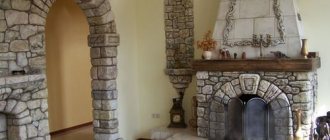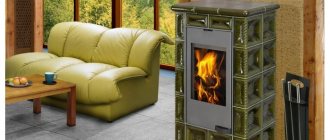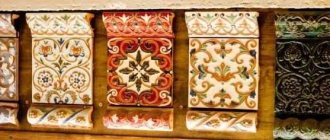Gas stoves for summer cottages are most often installed because of their versatility, efficiency, and functionality. However, many people are faced with the question: What is better, a gas stove for heating a house with your own hands or a purchased ready-made, fully equipped option? We will answer these and many other questions in this article.
Is there any danger?
Many people associate gas stoves with direct danger and to a certain extent they are right. The fact is that liquid gaseous fuel can burn at a certain speed. If the burner is not designed correctly, it may leak, which is dangerous to human life and health.
Gas stoves for summer cottages with a cylinder are also included in the dangerous category. However, in order for the operation of such a heating unit to be as safe as possible, liquid fuel is odorless, but for safety reasons a small amount of a characteristic fragrance is added to it.
Heating equipment can be connected to a boiler or pre-installed communications
As an alternative to a gas fireplace, you can use a more affordable and easy-to-install electric one.
Important: gas stoves for a summer residence will be completely safe to use if the burner is designed according to all the rules and is fully operational. In this case, the gas will burn completely under any operating mode or supply intensity. Also, soot and soot will not form or settle in the inside of the burner.
Interesting to know: gas stoves are also highly economical. They are suitable for any conditions, their operation is allowed even at medium latitudes. At the same time, the efficiency of such fireboxes increases to the maximum, in contrast to solid fuel brick stoves, the efficiency of which decreases by 8-15 percent.
Gas stoves for home use are very popular among summer residents, as they are able to heat a small space well. At the same time, the gas itself, due to the fragrance called mercaptan included in its composition, allows you to sense something is wrong in time in case of a leak. This component causes lacrimation, has a pronounced, characteristic odor, and is safe for health.
Remodeling a fireplace: step-by-step instructions
The old stove, once used for household purposes, was traditionally installed in a large central room and did not take up too much space. However, the appearance of the stove structure did not always evoke aesthetic satisfaction. All the more willingly the new owners will want to use an unnecessary relic of the past as a wonderful addition to the new interior.
Thus, for all repairs to convert the stove into a fireplace, you should stock up on the necessary tools, devices and materials, which include:
- refractory stove brick, the quantity of which depends on the amount of work. Finding it is not difficult: the easiest way is to visit the nearest construction market or construction supermarket;
- cement mortar;
- level;
- clay for mortar;
- Master OK;
- Bulgarian;
- chimney pipe (if the old one is in poor condition and requires replacement);
- facing tiles;
- fireplace door.
To simplify and visualize the desired result, you should prepare in advance a drawing of the desired fireplace, the external design of which is largely determined by the initial state of the stove. The existing furnace is inspected to determine its reliability, the durability of the existing casing, and the condition of the foundation. There is an opinion that earlier, in the Soviet era, everything was done much better, “for centuries” - of course, such an opinion is not unfounded, but you should not rely on it too literally: after all, time takes its toll. Therefore, it is better to make sure it is correct several times than to soon remodel a new, but already damaged fireplace.
Sometimes the durability and quality of a manufactured stove is truly surprising. In such cases, it makes no sense to disassemble the existing structure: it is better to save money and carry out further work using existing material. It is important to ensure that there is a gap of 20-30 centimeters between the foundation of the floor of the house and the foundation of the future fireplace, which must be filled with sand.
The depth of the firebox should be 50 centimeters, and the inner body of the fireplace must be lined with refractory bricks.
If all the necessary conditions are met, we proceed to inspect the existing chimney, because it will almost certainly need to be rebuilt. The requirements for chimneys for stoves and fireplaces are somewhat different: a fireplace chimney needs seven meters in height, a cross-section of 13*25 centimeters minimum. Next, you need to provide for the presence of specialized channels necessary to be present inside the entire structure in order to control the air flows passing along the doors. Thanks to this method, soot will not constantly and abundantly accumulate on the glass of the fireplace door.
Why gas?
Gas heating stoves for the home have many advantages. First of all, this is the affordable cost of natural gas itself. Maintenance of a liquid fuel device is cheaper than a solid fuel unit with similar power and functionality.
The advantages of this fuel also include:
- There is no need to load or prepare fuel. To start heating, simply turn on the heater;
- Warming up of the premises reaches its peak already 1-2 times after switching on. While to warm up a room using a wood-burning fireplace with your own hands, it will take about 3-4 hours;
- The particular effectiveness of such devices is achieved when installed in a bathhouse;
- A gas cylinder lasts for a long period of use, unlike coal or logs.
biofireplaces are safer, but less efficient than gas variations
Interesting to know: stoves with afterburning gas, like other simpler models, belong to the environmentally friendly variety. The fact is that during operation, the fuel burns almost completely, does not break down into elements harmful to nature, and reaches the stratosphere in smaller quantities.
How to make a stove from two gas cylinders for a garage
Getting started is no different from making a stove from a single gas cylinder. The easiest way is to place two containers with their long sides parallel to each other, one under the other. With this connection in the upper cylinder, the ash pan is not welded into the groove on the long side, but is connected to the lower one using metal strips left when cutting the hole. Firewood is placed in the lower part of the stove, and the upper container acts as a heat exchanger, retaining more heat.
The option of two containers will warm up the garage faster and retain heat longer
Heat exchange fins increase the efficiency of a garage stove made from 2 gas cylinders.
There are designs with perpendicularly welded cylinders, a cooking surface is installed in the lower one, and the upper one serves as a heat exchanger. To enhance heat transfer and better heat the garage, ribs made of metal plates are sometimes welded onto the top of the stove.
Advice! To prevent the grate from burning out when used too intensively, it can be made of a thick metal sheet with cut holes or long grooves.
Purchase or DIY?
A gas heating stove can either be assembled with your own hands or purchased in a ready-made, assembled state in a specialized store. Each of these options has its positive and negative sides.
Basic moments:
- It is strictly forbidden to use homemade gas equipment and devices in accordance with the safety rules prescribed by the Russian Ministry of Emergency Situations;
- The cost of high-quality, powerful heating equipment capable of heating a large house is about 800 dollars or more;
- The most budget-friendly, at the same time very high-quality, functional devices are domestically produced;
- An affordable, but less powerful option is mobile units, which have small dimensions and appropriate weight, allowing them to be moved from one room to another and transported.
The gas stove has a visual similarity to classic wood-burning fireplaces
The firebox can be framed in the required color and style
Important: gas ovens cannot be installed with your own hands, since in order to conduct gas and the necessary communications you must have knowledge, experience, and tools. In this case, the gas service specialist must confirm his work with appropriate documentation, and upon purchase the device itself is provided with a certificate indicating its suitability for use.
It’s interesting to know: since it is unacceptable to install gas kitchen stoves with your own hands, all you can do yourself is to additionally equip the device with a burner. It is important to remember that for these purposes only supercharged burners are allowed to be used. The use of atmospheric burners is strictly prohibited for household appliances!
How to increase efficiency
A potbelly stove made from a gas cylinder is a very gluttonous creature.
But if you install an adjustment window and make all joints sealed, then fuel consumption will be reasonable.
You can increase the efficiency of a potbelly stove from a cylinder by installing additional screens on the sides of the body. Another option, to increase the heat capacity of a stove from a gas cylinder, is to install a metal mesh around the body and chimney pipe, into which stones are placed according to the heater principle.
Choosing a gas stove
Portable gas stoves are more efficient. However, in order to make the right choice that will fully meet your expectations, we recommend that you familiarize yourself with the following information:
- A gas stove for the kitchen and home should be made exclusively of metal or cast iron. Only these materials can increase the efficiency and efficiency of the device;
- It is not recommended to gasify brick stoves made by yourself.
Bulky wall-mounted stone stove in the interior of the house
Interesting to know: gas heating stoves can be made of brick. However, in this case, the masonry must be of the highest quality, and the firebox is carried out almost continuously. In order for such a unit to be effective, the brick must be laid not massive, but small. In this case, the chimney system must contain various channels (for example, a Swedish or Dutch fireplace). The few advantages of this type include the creation of a healthy microclimate in the room, since the brick structure “breathes” well.
Selecting the design of a wood stove
Outdated and inefficient heating equipment is gradually becoming a thing of the past, which also affects homemade stoves. Nowadays, no one needs primitive iron boxes with a pipe and doors that devour firewood without good heat transfer. A modern potbelly stove should be economical and heat the room well. Therefore, advanced craftsmen are constantly working to improve steel furnaces.
To achieve the most efficient operation of a wood-burning heater, it is necessary to solve 2 questions: how to increase the efficiency of a potbelly stove and the burning time from one load, without increasing the quantity and price of the materials used. We present 3 homemade options where these tasks were successfully solved and implemented:
- three-pass stove made of two propane cylinders;
- pyrolysis stove with an air-fire-tube heat exchanger and a secondary chamber;
- A very popular design is “Bubafonya” with top burning of wood from a gas cylinder.
For reference. The first 2 units were developed, made and tested by our expert Vitaly Dashko, who kindly provided his photos and video materials.
If you are comfortable with a welding machine and have the necessary tools, then there will be no technical problems with production. Below we will present drawings and explain the technology of how to make a potbelly stove from a gas cylinder using all three options. But first, make your choice by reading the review of these stoves.
To make a stove you need a welding machine, a grinder, plumbing and measuring tools. You will need several clamps, at least 2 pieces
Three-way potbelly stove - operating principle and pros and cons
The master gave this homemade stove the playful name “Collider” because of its unusual appearance and good heat transfer. This wood-burning stove is made from two standard 50-liter propane cylinders welded to each other at an angle of 90°, as shown in the drawing. The operating principle is as follows:
- The first tank, laid horizontally, plays the role of a firebox and is accordingly equipped with doors and grates. An impressive portion of firewood is placed in it and set on fire.
- The second vessel is an air heat exchanger with internal partitions that slow down the flow of flue gases and force them to change direction three times and give off more heat. At the end, combustion products leave the heater through the chimney pipe.
- To increase the heating surface, both parts of the housing are equipped with additional ribs.
- An ash pan made of sheet metal is welded to the firebox below, the door of which regulates the supply of combustion air.
Sectional drawing of a homemade three-way wood-burning heater
Note. With the same success, instead of cylinders, you can use a steel pipe for a potbelly stove with a diameter of 300 mm and thin walls (4-5 mm).
The estimated power of the “Collider” is 10 kW with an efficiency of about 55%, which allows you to heat a room of up to 100 m² - a cottage, a greenhouse or a large garage (box). Practical tests have shown that in the mode of maintaining heat in a heated room, 1 load of firewood lasts for 1.5-2 hours. If you use a heating unit in a house with a smaller area (25-50 m²), the combustion duration will increase to 3-4 hours. Anyone who understands the topic will understand that for a homemade potbelly stove this is good economics.
Photo of the finished Collider stove with heat exchange fins
This long-burning stove has one downside - its strange appearance. But it is compensated by numerous advantages:
- ease of manufacture;
- quick warm-up and decent operating time from 1 load of solid fuel;
- the design is cheap, you only have to buy comfortable handles and also a pipe for the potbelly stove if you don’t have propane cylinders;
- due to the size of the firebox, long (80 cm) and massive logs are placed in the stove, which contributes to the duration of combustion;
- the unit can be made with a hob, as shown in the photo.
The "Collider", like any potbelly stove made from a gas cylinder, welded by yourself, can be supplemented by installing a water circuit, regulating the air damper in the ash pan door and an external fan. The dimensions of the stove can be changed in any direction by selecting smaller tanks or pipes of a different diameter.
The operation of a potbelly stove used to heat a 100 m² cafe is described in the video:
Review of a pyrolysis oven for 2 chambers
This small wood-burning stove, made from a 24-liter gas cylinder, was named “Pyaterochka” after the number of air heat exchanger pipes. It operates according to this principle:
- As in the previous case, the cylinder laid on its side serves as a combustion chamber, and an ash pan is attached to the bottom. The role of the grate is played by slits cut in the wall of the vessel.
- There is an opening at the top of the tank where 5 vertical heat exchanger pipes are adjacent. Hot flue gases move along them and thus release some of the heat into the room.
- From the heat exchanger, combustion products enter the secondary chamber, where heated air is supplied separately through a separate tube. Thanks to this, the combustible gases formed in the firebox are burned and release additional heat, after which they are directed into the chimney.
Drawing of a long-burning pyrolysis potbelly stove with a gas afterburning chamber.
The results of practical tests of the heater are as follows: a room of 30 m² is heated to 20 °C for 1 hour, after which one laying of wood is enough for 1.5-2 hours, depending on the operating mode. Approximate power – 5 kW. As you can see, in this design the burning time is reduced due to the reduction of the firebox, but the stove is very compact and will fit in any room. Yes, and it heats up quite well.
Advice. Do you want to increase the burning time to an average of 4 hours? Then study the drawing of another option, which shows the same pyrolysis potbelly stove, made with your own hands from a 50-liter gas cylinder. The design of the heating units is identical, the only difference is in the volume of the tanks used as a firebox.
This is what a two-chamber homemade stove looks like.
2 rods are welded on top - you can put a saucepan or kettle with water. Thanks to the efficient burning of wood, the Pyaterochka stove is more economical than the Collider, although it is more difficult to assemble. In terms of the cost of materials, the difference between them is small - the first has 2 cylinders, the second has 5 pipes with a diameter of 57 mm and a length of 40 cm. A separate advantage of the stove is the ability, after heating, to burn wet wood and any debris without losing heating intensity. The remaining advantages are the same - low cost, ease of use and the possibility of modernization.
Another good piece of advice. It is quite natural that after replacing a small cylinder with a standard one (50 l), you want to increase the power of the heater and add 2-3 more pipes to the heat exchanger. Remember that the flow area and chimney draft should increase accordingly. Otherwise, you will waste materials and time, because due to insufficient draft, the outer sections will remain cold and the furnace power will not increase.
An enlarged version of Pyaterochka from a large 50 l cylinder
Top burning stove "Bubafonya"
By and large, “Bubafonya” cannot be classified as a potbelly stove, since it has a radically different operating principle. But it is impossible to ignore this stove due to its wide popularity due to the burning time from 1 load of wood from 6 to 10 hours. At the same time, the heater is famous for its numerous shortcomings, which we will discuss later.
The operation algorithm of the Bubafonya long-burning stove shown in the drawing is as follows:
- The fuel tank is a 50 liter propane cylinder standing vertically. Through a hole in the top cover, an air supply pipe enters inside, ending with a thick metal disk. Steel strips are attached to the bottom, distributing air in all directions.
- When the firebox is filled to the top with firewood, the heavy disk presses it down and causes it to sag as it burns. Ignition is also done from above, and only then the pipe with the load is lowered.
- The combustion air supply is regulated by a damper installed at the upper end of the pipe. The chimney pipe is cut into the side wall of the cylinder under the lid itself.
Drawing of a top combustion furnace and arrangement of air distributors
Note. The place where the pipe passes through the lid is not sealed and secondary air is sucked in there, which helps to burn out the flammable gases above the disk when the oven is properly heated.
The strengths of “Bubafoni” are a decent operating time, simplicity and the possibility of conversion into a top-combustion boiler (a stove is made with a water jacket, which is described in a separate material). But the weaknesses forced many garage owners to abandon such potbelly stoves:
- the stove cannot be loaded until all the fuel has burned;
- if the damper is closed, the firebox will not go out and will smolder for a long time, because secondary air enters it;
- without good draft, the heater smokes into the room;
- in the slow burning mode, the stove heats weakly, and the chimney pipe becomes intensively clogged with soot;
- To enter normal mode, the unit must warm up well, which consumes ¼ of the fuel.
On the left in the photo is a close-up of the air damper, on the right are homemade heat exchange fins from profiles for installing gypsum boards
For reference. To burn off soot in the chimney, you need to run the Bubafonya at maximum speed every time you light it.
Finally, let's sweeten the pill a little. Despite all the shortcomings, a long-burning stove made from a gas cylinder does not lose popularity; in addition, it successfully operates on sawdust and various flammable debris.
Gas infrared ovens
Gas infrared ovens are highly efficient. They are suitable for heating a summer house, private house or standard apartment. Their features include:
- They heat the rooms fairly quickly and evenly;
- They have small dimensions;
- Thermal energy spreads throughout the room and does not go only to the ceiling or floor;
- A comfortable temperature is formed, the air does not dry out;
- To achieve fast heating and maximum efficiency, the design can have a ceramic finish;
- The cost of such heating equipment is affordable;
- Mostly, models are equipped with an open combustion chamber.
The built-in gas fireplace is installed in a pre-prepared niche
Main elements and components of gas boiler equipment
Interesting to know: gas bread ovens are very popular today. They have proven themselves positively in both small and fairly large industries. Gas ovens with electric ovens are designed for wicking. Some models are additionally equipped with a hob on which you can cook food and heat water (analogues of standard stoves). Gas baking ovens with an electric oven are considered the most efficient and functional.
In kitchen heating stoves, about a hundred or more baked goods can be cooked at a time. Since such devices are quite economical, they do not require industrial gas or electricity to operate. Thus, you can install the devices at home with your own hands and open your own business.
Interesting to know: gas furnaces for firing ceramics, which are widely used both at home and in production, are no less popular. In order to heat small parts, the elements can be assembled with your own hands. To do this, use a simple tin can.
Additional Information
A gas stove for heating a private home must have a special certificate, the validity of which is checked before installation. The following details must also be taken into account:
- Determine the required power. To do this, sum up the area of all the rooms of the house or apartment that you want to heat. On average, about one and a half kilowatts of power are consumed per square meter;
- The premises must have ceilings with a height of at least two meters and an area of about 7-10 cubic meters;
- The firebox must be framed with a metal plate;
- If you want to use automatic blowing, the fireplace is additionally equipped with power from the electrical network.
Modern gas stove in high-tech style
The principle of connecting a gas fireplace with a water circuit
Heating unit with decorative firewood
Gas heating stoves for summer cottages stand out against the backdrop of electric, wood-burning fireboxes. They are light in weight, do not require the assembly of an additional foundation, and are highly powerful. The installation requirements for such a unit are also minimal. It can be placed both in a private house and in a standard apartment.
Drawings of a stove for a garage from a gas cylinder
The dimensions indicated in the figures are quite relative and are tied to the dimensions of the cylinder chosen for the stove. The diagrams give an idea of the principle of operation, design features and method of connecting containers. Some of the parts (burner, shaped handles) can be ignored, but the main structural elements (ash pan, grate, chimney) are necessary for the efficient and safe operation of the stove.
From a large diameter cylinder you can make a stove for a garage with a burner in the upper part. The ash pan is the lower part of the firebox where ash accumulates, and the ash pit is the hole in the side wall of the stove to control draft. The internal partition in the garage stove increases heat transfer due to convection
Important! The thickness of the stove walls should be within 3-5 mm. Moreover, the upper value is recommended, since 3 mm steel will burn out quite quickly.











